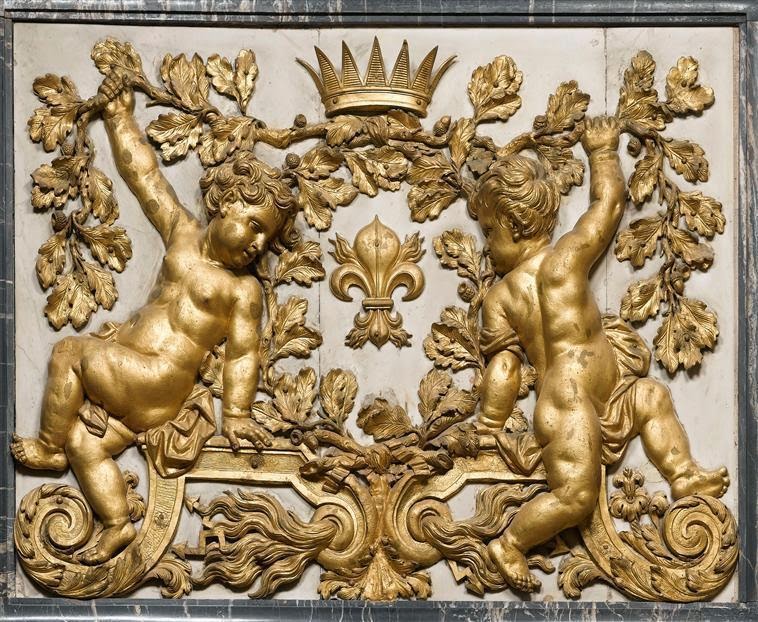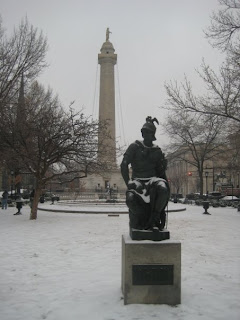Baltimore's Washington monument built between 1815-1829
I have been lucky to live in the finest Historic Neighborhood in Baltimore called Mount Vernon after George Washington's beloved home. The neighborhood originally was home to the city's most wealthy and fashionable families. I also lived a block away from the first monument to Washington in America known as the Baltimore Washington Monument. The neighborhood had a old world feel to it that reminding me of New Orleans, Europe, New York and Many other places. Many movies are shot here because if it's charm. Three times a day for five years my dog played in Mount Vernon Place one of four parks designed by Frederick Law Olmsted in the 1870's that surround the Washington Monument. Yesterday we toured the State House in Annapolis where George Washington turned over his commission as Commander-in-Chief of the Continental armies. The statue of Washington in Baltimore depicts George turning over his commission. Just as the French artist Claude Monet painted more than thirty views of Rouen Cathedral during different seasons I have photographed the Monument different times of the year.
Little did I know that when I toured Baltimore and the East Coast in August of 1997 with my French Boyfriend that Hurricane Katrina would bring me to the same streets I walked as a tourist 7 years latter.
Baltimore's Washington Monument pre-dates the more famous one in Washington DC. It is, in fact, the Nation's first civic memorial to George Washington . Built in the neo-classical style, the 178-foot monument was designed by architect Robert Mills and was completed in 1829, fourteen years after construction began. Mills also designed our more famous sister monument in Washington, D.C. which opened in 1855.
The marble tower rises 178 feet (the DC one is 555 feet tall) from the highest point in Baltimore. At one time ships entering the harbor could see the monument, which is only 10 blocks from the Inner Harbor. Today downtown's skyscrapers block the vista.
Just 10 years after George Washington died in 1809, a group of citizens organized a lottery to raise $100,000 for Baltimore's monument. Robert Mills, who later became architect of the other Washington Monument, won the commission to design Baltimore's tribute to Washington and $500.00. Of the entries received, the Managers chose that of Robert Mills, the most grand (and expensive) design submitted: a massive column resting on a base with balconies at several levels, inscriptions, and a crowning statue representing Washington, dressed as a Roman warrior, riding in a horse-drawn chariot. Mills, a native of Charleston, South Carolina, who prided himself on being the first entirely American-trained architect, was awarded the commission for the Monument in 1815. Begun in 1815, the grandiose design was scaled back several times before its completion in 1829. A Doric column rising from a square base, the monument is topped with a statue of Washington in a Roman toga.
When the winning design was announced, the owners of the houses surrounding the proposed site rose in opposition, fearing that such a tall column would surely fall over on them, and even if it remained standing, would probably attract lightning. Colonel John Eager Howard, Baltimore's own Revolutionary hero, came to the rescue, donating land from his immense estate, Belvidere, for the placement of the monument honoring his former Commander-in-Chief. The donated site, then called Howard's Woods, was a hill well north of the Baltimore town of 1815, where a falling statue would be unlikely to harm anyone. Thus it was that on July 4, 1815, a crowd estimated at between 25,000 and 30,000 townspeople and assorted dignitaries assembled at the site of the proposed monument for the laying of the cornerstone.
Construction of the Monument began in 1815 and continued for nearly 15 years. Both the marble for the column and the fine white marble for the statue of Washington atop the column came from Baltimore County quaries. By 1824, the column and the capital to hold the crowning statue had been completed, but soaring costs--nearly twice the $100,000 authorized by the legislature--had forced Mills to simplify the design significantly, resulting in the unadorned shaft we see today.
In 1826, the project Managers held another competition calling for designs from sculptors for the statue of George Washington to be placed on top of the column. After reviewing the few submissions, the Managers awarded the statue commission to Enrico Causici of Verona, Italy, who had sculpted several panels of the Rotunda of the United States Capitol. Causici created the statue of Washington out of three blocks of marble weighing about seven tons each. Financial considerations having eliminated the Roman chariot statue design, the sculptor instead depicted Washington resigning his commission as Commander-in-Chief of the Continental armies, a most appropriate subject as the incident took place in the senate chamber of the State House in Annapolis, Maryland, where the United States Congress sat for a brief time in late 1783.
To execute the daunting task of raising the statue (approximately 16 feet high) to the top of a 160 foot high column, Causici and Mills called upon Captain James D. Woodside of the Washington Navy Yard, a rigging specialist. Captain Woodside devised an ingenious system of pulleys, levers and braces, and successfully hoisted the lower two portions of the statue into place. Finally, on November 25, 1829, the populace once again assembled in Howard's Woods as the final section of the statue was raised to the top of the column during the Monument's dedication ceremony.
William Rusk, in his book "Art in Baltimore: Monuments and Memorials", tells the following story about the raising of Italian sculptor Enrico Causici's marble statue of Washington in 1829. "Tradition recalls a prodigy occurring when the statue was raised to the summit of the monument - a shooting star dashed across the sky and an eagle lit on the head of the settling general."
The monument is referenced by Herman Melville (as Ishmael) in Chapter XXXV (The Mast-Head) of Moby-Dick, "Great Washington, too, stands high aloft on his towering main-mast in Baltimore, and like one of Hercules' pillars, his column marks that point of human grandeur beyond which few mortals will go."
Visitors can climb its 228 steps for one of Baltimore's best views from a small observation area! In the base, a small museum with chronicles the history of the monument. Admission is $1.
Enrico Causici of Verona, Italy, who had sculpted several panels of the Rotunda of the United States Capitol. Causici created the statue of Washington out of three blocks of marble weighing about seven tons each. Financial considerations having eliminated the Roman chariot statue design, the sculptor instead depicted Washington resigning his commission as Commander-in-Chief of the Continental armies
George Washington by Enrico Causici seen thru a 1840's Greek Revival building on the square
George Washington with a Roman haircut and a toga by Giuseppe Ceracchi an Italian sculptor, active in a Neoclassic style in Italy, England and the nascent United States, who was a passionate republican during the American and French revolutions.
The George Washington museum at the base of the monument
The George Washington museum at the base of the monument
A original lottery ticket to raise $100,000 for Baltimore's monument
Graffiti on the way up to the top.
The beautiful brick work under the George Washington statue
One of Baltimore's best views
President Abraham Lincoln was invited and attended dinner at the house strait ahead to the right 2th from the corner
Neoclassical Cast iron
The iron fence around the base was designed by Mills and added in 1838. It contains some of the symbolism that had been deleted from the column due to cost considerations.
One of the four depictions of War, Peace, Order and Force on the square given to the City by Walters in the 1880s, the Walters Art Gallery owns more than 150 other Barye bronzes as well as pieces of his work in other media.
The iron fence around the base was designed by Mills and added in 1838. It contains some of the symbolism that had been deleted from the column due to cost considerations.
Spring time in Baltimore
Winter
Sunrise






































No comments:
Post a Comment